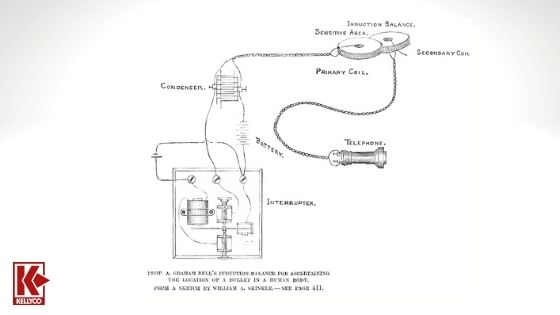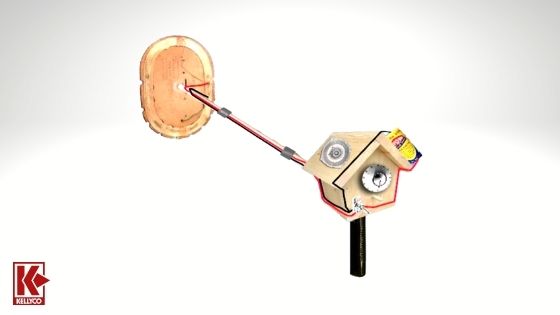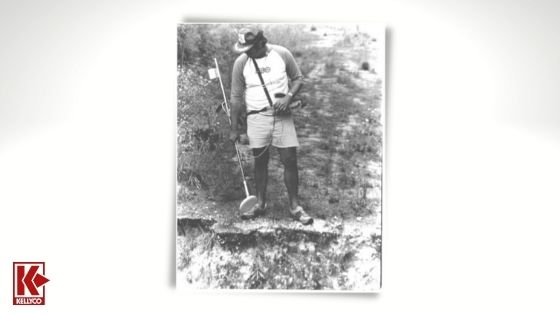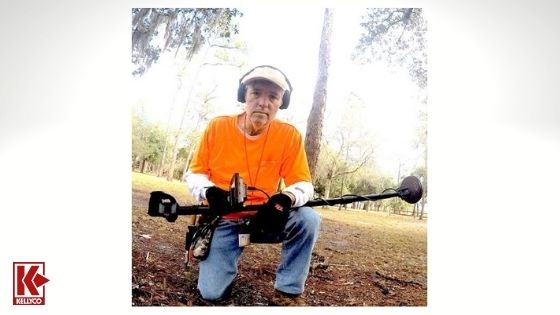Evolution of Metal Detecting
Published by Jim Fielding on 10/05/21
I was an early player in the hobby of metal detecting in 1965 when the evolution of metal detecting had already started. We considered it treasure hunting at the time, not so much metal detecting perse, but as a call to adventure, the metal detector itself is just one more tool of many, hi-tech and low-tech, all designed to get us onto the treasure site and into the ground pronto!
We referred to ourselves as THer’s (treasure hunters) which has since evolved into the latest popular moniker, detectorist, probably derived from a popular British TV show of the same name. As far as how metal detecting evolved, we need to go back in time, quite a bit farther back than my 56-years in the hobby, deep into the mid-19th century.
In the beginning, humanity’s interest in the physical laws of the universe set us on a course that would end in the development of that magic wand we all love, the metal detector!
Wizards of the 19th Century
Almost all the electronic devices we yawn over today are rooted in electromagnetism; literally the core reason the metal detector exists today! Electromagnetism, as a dynamic force, was always suspected by some of the brightest minds of the early 19th century, but never proven.
Unproven that is, until Hans Christian Orsted, a Danish Physicist, was preparing for a science demonstration in 1821, got a field compass a little too close to a wire from a voltaic pile (early battery) that was part of the demo.
When he hit the switch, the compass needle pegged itself toward the wire! Proof positive of an invisible force emanating from an actively energized conductor!
Almost exactly 10-years later, in 1831, the English Physicist Michael Faraday discovered magnetic induction, in short, a metal conductor moving in an electromagnetic field caused a change in an attached galvanometer, like today’s voltmeter, and electrodynamics was born, the basic reason metal detectors are possible! Here is Faraday’s Law, to the right, as an equation.
Very Early Metal Detectors and Applications

Alexander Graham Induction Balance
The first metal detector of mention was built in 1874 by a Parisian Electrical Engineer named Gustave Pierre Trouvé. He was attempting to design a device for locating bullets and shrapnel in humans.
Alexander Graham Bell, the inventor of the telephone, also created a rather crude metal detector in 1881 to try and save a painfully dying U.S. President James A. Garfield by locating the lead projectiles in his body from an assassination attempt.
The search was unsuccessful because Bell neglected to consider the iron bedsprings below Garfield, confusing the machine and masking the low-conductivity targets.
Going forward, the same type of metal detector designed for locating bullets and shrapnel in people was expanded along similar lines to locate buried explosive battlefield mines during both WWI and WWII; a preventative measure to keep shrapnel out of people in the first place. New technology was born!
The Birth of Portable Metal Detectors
German immigrant Dr. Gerhard Fischer, while working on a radio-direction navigation device of his own design, was field-testing it when the sensor neared an outcrop of metallic ore and caused a reaction in the instrument.
Impressed with the way the equipment detected the metal, Dr. Fischer worked on designing the first truly portable metal detector, patenting it in 1925. The first commercial model of this machine, called the M-Scope, was available for the first time in 1936.
It was featured in the publication “Radio For Everybody” as a “Radio Treasure-Finder” for the geologist looking for ore deposits. The device looked similar to the deep-seeking two-box detectors of today.
During the 1940s and 1950s, treasures were being found along Central Florida’s east coast in the form of Spanish silver and gold cob coins, coming ashore from the wreckage of a Spanish treasure fleet that wrecked just off the beach, in the year 1715, victims of a hurricane.
These treasure coins were being found with surplus WWII mine detectors. These were heavy, hard-to-use machines, and though portable, they were a bear to maneuver. I recall back in 1986 when I ran into an old-timer standing on that very beach.

Spanish Silver Cob Coin
As I nodded and passed by, swinging my metal detector, he stopped me and told me when he was a kid, back in the early days along the beach, he and his friends would find small blackened (with silver oxide) disks by the dozens, and played games, skipping thousands of the silver treasure coins off the waves back into the sea.
He said, “I literally threw away my retirement and didn’t know it!” Spanish shipwreck coins may still be found there today, after a violent hurricane or high surf conditions.
Building My First Metal Detector In 1965
I had found a how-to article in a copy of Popular Mechanics in 1965. The hobby was very new then. I scavenged the parts I’d need, and my father’s big Wellers Electric Soldering Gun got a workout that day building my first simple BFO {Beat Frequency Oscillator) detector!
It certainly was not a high-tech-looking instrument, but it worked!. Activating the detector for the first time, I took it outside and immediately got a target tone. My father was amazed that it worked at all and helped me dig my very first target; a flatter-than-flat aluminum Flagstaff Beer can!
It was good for locating targets that were big, and quite shallow. It had to be constantly tuned as you used it because BFO detectors were cursed with what was known as oscillator drift.

Beat Frequency Oscillator Detector
This would be corrected a few years later.
The BFO principle utilizes the electromagnetic field emanating from the search-coil which creates “eddy currents” in the detected object, with the conductive object now using the eddy currents to create its own electromagnetic field, which is then picked up by the detector.
I later owned a Jetco detector and built several more from Heathkit kit detectors. Eventually, I owned almost every detector model made. But meanwhile, more evolutionary changes were coming!
Improving The Mid-20th Century Machine

Metal detecting on the beach in the mid-20th century
Metal detectors were somewhat difficult to use in the mid-20th century due to frequency drift.
Thankfully Charles Garrett had managed to lick the metal detector’s frequency-drift problems by redesigning critical circuits and using higher quality mil-spec components, after which the metal detector became much more stable and able to hold that stability while being used in the field.
Now you could search rather than fiddle with the controls. Analog metal detectors of the day, like my 1982 Garrett Deepseeker, were heavy and a spaghetti dinner of wiring, resistors, capacitors, and transistors mangled inside a metal housing, with the batteries installed through a small metal door with the actual battery connectors deeply embedded somewhere in all that wiring!
But they were quite well made and reliable. One of my pet peeves of the day, the handle on these detectors seemed to have been designed by sore-arm experts or someone who didn’t want you out there metal detecting.
About 20-minutes into a hunt, you were willing to tell anyone where the fresh-baked cookies were hidden if they would only let you put the machine down! Early detectors were audio-only, with headphones eventually becoming part of the setup to clear outside sounds and amplify the whisper signals that meant deep silver or gold.
Somewhat later, metal detectors were fitted with analog meters, which looked good but rarely added much target information, other than you had a target under the coil. But you already knew that so…
The meter made people on the beach ask why you were using a Geiger-counter. It was soon discovered that assigning a very low frequency improved their depth and different frequencies made targeting specific metals and alloys easier.

Jim and his first modified hip-mount Deepseeker
High frequencies in the VHF and UHF range suffered from what is known in electronics as attenuation, which is basically signal absorption by the surrounding matrix, or the ground, as it were.
It was discovered that lower frequencies (5 kHz – 8 kHz) favored more conductive metals such as silver, copper, and brass, while higher frequencies (12 kHz – 22 kHz) in the VLF band, favored lower conductivity metals such as lead and gold.
Due to the very low frequency, the resulting electromagnetic field passed through soil and rock like they were not there. With this discovery came how you ordered a detector in the frequency range of your intended use…shooting gold nuggets, silver coins in the park, or relics in the woods.
The Metal Detector Evolves Further
As time moved on, and we went crazy digging targets that seemed to vanish, or were garbage, or tried to find coins in a field of bottlecaps. Then suddenly, out of the blue, the guys with the brains developed discrimination technology based on electronic principles I’m not even going into! In VLF-type detectors this was a motion-based process…discriminating a range of specific targets required the coil to be in motion.
Target notching was also developed, which is dumping target signals that are in-between an upper and lower range of wanted targets. Do you like nickels and dimes but despise zinc pennies? Notch em’ out! New sizes and types of exchangeable search coils were designed; Concentric coils; very sensitive to small targets and the only game in town for locating small gold jewelry!
Double-D (wide-scan) coil; very stable and less prone to target masking. The mix and match coil types and sizes could make your detector into a completely different machine in the time it takes to change it! You could go from a small concentric coil to find Grandma’s earring, to a large double-d coil to find that deeply buried cache of gold coins! The possibilities are endless!
21st Century Evolution Onward
Latter 29th and early 21st century VLF and pulse induction machine improvements included ergonomic handle and armrest design, digital computerized metal detectors that we could not even have dreamed of in the mid-20th century!
Bright LED illuminated liquid-crystal screens, multiple recessed controls, wireless headphones, and pulse induction machines whose performance on land and underwater we could not have touched!
And those same metal detectors have advanced to the point of running simultaneously on multiple frequencies, giving the treasure hunter a bit more bang for his buck! However, the biggest improvement I can think of in my 56 years of metal detecting, that most positively impacted the metal detecting hobby would be the introduction of the pulse induction electronic pin-pointer!
Are you kidding me? A small, light-weight, pulse detector the size of a small flashlight, capable of finely pinpointing a target within a quarter-inch radius up to 3” deep or more, with built-in target vibration and wireless capability? And the same device is also waterproof and can identify a ferrous target from a non-ferrous target?
I would have never believed it and I continue to be amazed every day at the ever-evolving hobby of metal detecting!

Jim Fielding, author of this article
We are at the end of my recollection of the evolution of metal detecting, and of course, I left a lot of details out, but the evolution of this great hobby will continue long into the future.
To totally address the evolution of metal detecting would require book-length work! And in the end, I do find it ironic that the metal detector was initially developed in 1874 to find bullets, and here we are, in 2021, assisting the police during an evidence hunt, still looking for those bullets! Gustave and Alexander would have been proud!
